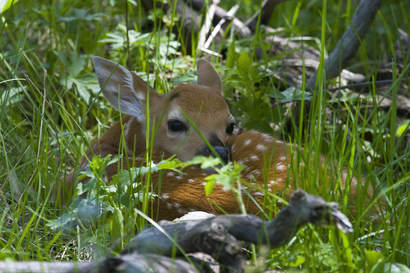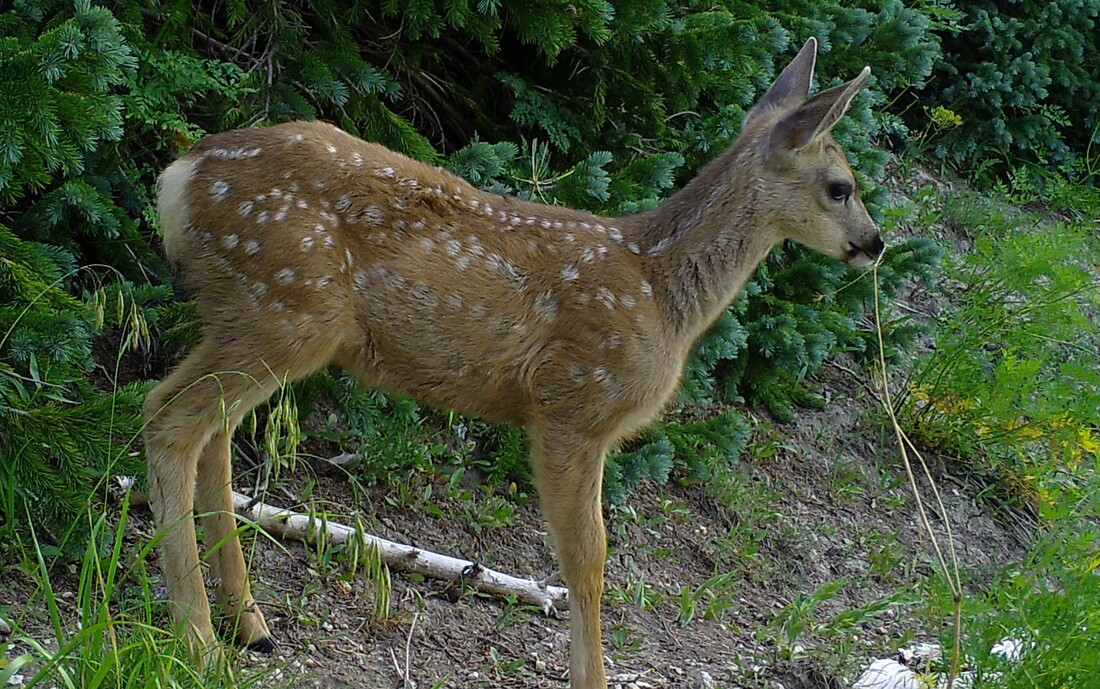
Mule Deer
Featured Animal: July 2015
By Dr. Nicki Frey
Introduction
Mule Deer (Odocoileous hemionus) : Finding Fawns
Summer is the time of year when we get out into the mountains to hike, bike, fish, and boat, to name of few of the wonderful recreational opportunities in Utah. Sometimes in our wanderings we come across juvenile wildlife without their mothers - “babies” - and it is our natural instinct to want to help. We pick up the "abandoned" baby - deer, rabbit, bird - and take it home in an attempt to save it. What we don't understand is that there are many reasons why we might come across a juvenile all alone. It is most likely that the animal has not been abandoned and is in no trouble at all. In the early summer you might come across a mule deer fawn while hiking in the woods.
Mule deer are common throughout Utah, spending most of their time in the foothills and mountains. Mule deer offspring, “fawns”, are born late April - June. They are precocial, meaning they are born with fur and their eyes are open. They can stand within minutes of being born, and can walk within a few hours. It is common for mule deer does (females) to give birth to twins. Although fawns are able to walk, they are not very strong for a few weeks; this coupled with their size makes them particularly vulnerable to predators during the first couple weeks of their lives.
Biology and Identification
Mule deer have several strategies to keep them safe as fawns. First, they are born with brown fur speckled with white dots. This color pattern helps them to blend in with the environment, especially woodlands with bits of light peeking through. Additionally, fawns don’t have a strong odor. Most of their predators - mountain lions, bears, coyotes - hunt by smell. Thus, fawns are difficult to find during this time.
During the first few weeks of their lives, mule deer mothers will hide their fawns from predators by having them bed down among the grass. Once the fawn is hidden, the mother can safely go in search of food. She needs to eat in order to produce milk for the fawn. However, she does not go too far away from her fawn. When a human (a potential predator) approaches, she stays out of sight, in order to protect herself and her fawn. While you may not see her, she is most likely nearby and will return for her fawn once you leave.
What do you do if you find one?If you are lucky enough to find a fawn or other juvenile wildlife, step quietly away from the animal. Take a picture from a distance, to remember your experience. Disturbing it may cause it to cry out, alerting predators in the area. Your scent could lead a predator to the fawn, so don't touch it! There are many predators that have learned to follow human scent in search of food. So, don't go near the fawn (or any other juvenile animal). Walk straight past it, looping away from the animal.
Featured Animal: July 2015
By Dr. Nicki Frey
Introduction
Mule Deer (Odocoileous hemionus) : Finding Fawns
Summer is the time of year when we get out into the mountains to hike, bike, fish, and boat, to name of few of the wonderful recreational opportunities in Utah. Sometimes in our wanderings we come across juvenile wildlife without their mothers - “babies” - and it is our natural instinct to want to help. We pick up the "abandoned" baby - deer, rabbit, bird - and take it home in an attempt to save it. What we don't understand is that there are many reasons why we might come across a juvenile all alone. It is most likely that the animal has not been abandoned and is in no trouble at all. In the early summer you might come across a mule deer fawn while hiking in the woods.
Mule deer are common throughout Utah, spending most of their time in the foothills and mountains. Mule deer offspring, “fawns”, are born late April - June. They are precocial, meaning they are born with fur and their eyes are open. They can stand within minutes of being born, and can walk within a few hours. It is common for mule deer does (females) to give birth to twins. Although fawns are able to walk, they are not very strong for a few weeks; this coupled with their size makes them particularly vulnerable to predators during the first couple weeks of their lives.
Biology and Identification
Mule deer have several strategies to keep them safe as fawns. First, they are born with brown fur speckled with white dots. This color pattern helps them to blend in with the environment, especially woodlands with bits of light peeking through. Additionally, fawns don’t have a strong odor. Most of their predators - mountain lions, bears, coyotes - hunt by smell. Thus, fawns are difficult to find during this time.
During the first few weeks of their lives, mule deer mothers will hide their fawns from predators by having them bed down among the grass. Once the fawn is hidden, the mother can safely go in search of food. She needs to eat in order to produce milk for the fawn. However, she does not go too far away from her fawn. When a human (a potential predator) approaches, she stays out of sight, in order to protect herself and her fawn. While you may not see her, she is most likely nearby and will return for her fawn once you leave.
What do you do if you find one?If you are lucky enough to find a fawn or other juvenile wildlife, step quietly away from the animal. Take a picture from a distance, to remember your experience. Disturbing it may cause it to cry out, alerting predators in the area. Your scent could lead a predator to the fawn, so don't touch it! There are many predators that have learned to follow human scent in search of food. So, don't go near the fawn (or any other juvenile animal). Walk straight past it, looping away from the animal.
Helping Young Fawns
Moving the animal or taking it home with you is akin to "kidnapping." You have essentially removed the baby from where the mother can find it. If somebody you know has taken a young fawn, immediately return the fawn to the exact location where it was found. When returning it, wear rubber gloves to decrease your scent. Take a towel with you. Once at the release site, and wearing your rubber gloves, rub the towel in the grass, and then all over the fawn. Walk away from the fawn and leave the area. The mother will return to her baby. If you return to the area in 3-4 hours and the fawn is still there, the mother has probably left the area. The longer the fawn is away from the site, the higher the probability that doe has given up hope of finding her baby, and has left the area.
On rare occasions people come across deer fawns that are in need of assistance or hurt. Perhaps a mother has been hurt - hit by a car, killed by a predator -- and cannot return. If you find a fawn wandering aimlessly and crying, there is a good chance that it has lost its mother. Contact the Utah Division of Wildlife Resources state office for assistance (801-538-4700). Their website also lists regional office contacts (www.wildlife.utah.gov)
Animal Injury
If the deer appears to have a broken leg or other injury, but is standing and walking, leave the animal alone. Wild animals have an amazing capacity to heal. Chasing the animal to capture and "help" it would only injure it more. If you are unsure if the animal can heal on its own, take a picture, and contact the Utah Division of Wildlife Resources or Utah State University Extension (extension.usu.edu/wildlifeconflicts; 435-586-1924) for assistance.
If you hit and kill a doe (female deer) while driving during the early summer, pull the animal far off of the road. There could be a fawn nearby. If so, it will stay by its mother for hours; if the mother is close to the road, there is the potential for the fawn to get hit too.
For most of us, seeing wildlife while recreating outdoors is one of the best experiences we can have. Getting to see a mule deer fawn bedded down is a rare occasion, and an exciting one. Acting responsibly around the fawn will keep it safe and leave you with a positive story you can share with friends and family.
Moving the animal or taking it home with you is akin to "kidnapping." You have essentially removed the baby from where the mother can find it. If somebody you know has taken a young fawn, immediately return the fawn to the exact location where it was found. When returning it, wear rubber gloves to decrease your scent. Take a towel with you. Once at the release site, and wearing your rubber gloves, rub the towel in the grass, and then all over the fawn. Walk away from the fawn and leave the area. The mother will return to her baby. If you return to the area in 3-4 hours and the fawn is still there, the mother has probably left the area. The longer the fawn is away from the site, the higher the probability that doe has given up hope of finding her baby, and has left the area.
On rare occasions people come across deer fawns that are in need of assistance or hurt. Perhaps a mother has been hurt - hit by a car, killed by a predator -- and cannot return. If you find a fawn wandering aimlessly and crying, there is a good chance that it has lost its mother. Contact the Utah Division of Wildlife Resources state office for assistance (801-538-4700). Their website also lists regional office contacts (www.wildlife.utah.gov)
Animal Injury
If the deer appears to have a broken leg or other injury, but is standing and walking, leave the animal alone. Wild animals have an amazing capacity to heal. Chasing the animal to capture and "help" it would only injure it more. If you are unsure if the animal can heal on its own, take a picture, and contact the Utah Division of Wildlife Resources or Utah State University Extension (extension.usu.edu/wildlifeconflicts; 435-586-1924) for assistance.
If you hit and kill a doe (female deer) while driving during the early summer, pull the animal far off of the road. There could be a fawn nearby. If so, it will stay by its mother for hours; if the mother is close to the road, there is the potential for the fawn to get hit too.
For most of us, seeing wildlife while recreating outdoors is one of the best experiences we can have. Getting to see a mule deer fawn bedded down is a rare occasion, and an exciting one. Acting responsibly around the fawn will keep it safe and leave you with a positive story you can share with friends and family.



